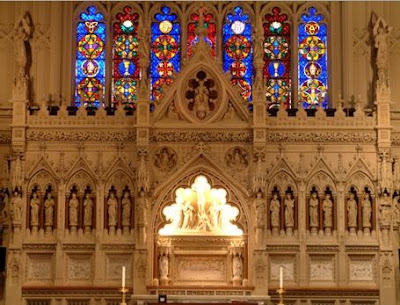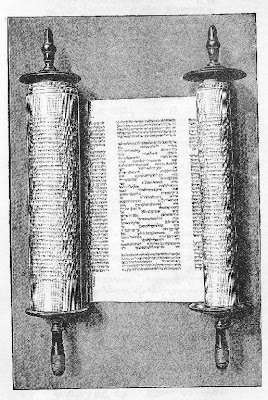Here I'll provide a short post about hymns for Apostles and Evangelists (the full listing for Apostles and Evangelists is here); if you'd like to read the whole longer initial entry, see the post from June 11, the Feast of St. Barnabbas.
Hymn Melodies for the whole year from the Sarum service books lists a variety of hymns to be sung on the feast days of Apostles and Evangelists, and the LLPB provides two mp3s that match up with Hymn Melodies for the whole year. First, the hymn listed for Lauds and Evening Prayer (using two different tunes): "Let the Round World With Songs Rejoice" (mp3), which in Latin is Exultet caelum laudibus. Here is the chant score for this melody, the one listed for Evensong:

Second, "The Eternal Gifts of Christ the King" (mp3); in Latin, this is Aeterna Christi Munera. I've linked to the St. David's Compline Choir version of this before; here it is again. Here's the chant score:

Here is the version from my sources, which is unlike any of the above; still haven't found out much about it.

From Mission St. Clare, on James:
And since this is the St. James - St. James of Compostella, that is - I'll add here a link to a CD of songs in his honor, by the French ensemble Discantus; these songs have been taken from the Codex Calixtinus, the medieval manuscript in which is found a great deal about that pilgrimage, and were, as I understand it, the songs sung by the pilgrims themselves. My favorite on that CD is #10, "Alleluia, Iacobe Sanctissime" - "Iocobe" being, as Mission St. Clare notes, the Latin for "James." The words are these, from Psalm 4, in Latin on the left and (approximately) in English on the right:
Listen to the clip of this song here:
Or go Écouter to all the samples at French Amazon, if you like! It's really pretty stuff, and I wish I could post it here directly.
There are some images of St. James the Greater at Textweek; how about this one, for instance, about which it says:
Now there's a group that doesn't get much airtime! Here's the polyptych:

Polyptychs of James were apparently the thing, for some reason! Here's another:

But I like this one best, from Georges de La Tour (and hanging - of course! - in the Musée Toulouse-Lautrec):

Hymn Melodies for the whole year from the Sarum service books lists a variety of hymns to be sung on the feast days of Apostles and Evangelists, and the LLPB provides two mp3s that match up with Hymn Melodies for the whole year. First, the hymn listed for Lauds and Evening Prayer (using two different tunes): "Let the Round World With Songs Rejoice" (mp3), which in Latin is Exultet caelum laudibus. Here is the chant score for this melody, the one listed for Evensong:

Second, "The Eternal Gifts of Christ the King" (mp3); in Latin, this is Aeterna Christi Munera. I've linked to the St. David's Compline Choir version of this before; here it is again. Here's the chant score:

Here is the version from my sources, which is unlike any of the above; still haven't found out much about it.

From Mission St. Clare, on James:
James the son of Zebedee (see People, right) and his brother John were among the twelve disciples of Our Lord. They, together with Peter, were privileged to behold the Transfiguration (Matthew 17:1 = Mark 9:2 = Luke 9:28), to witness the healing of Peter's mother-in-law (Mark 1:29) and the raising of the daughter of Jairus (Mark 5:37 = Luke 8:51), and to be called aside to watch and pray with Jesus in the garden of Gethsemane on the night before His death (Matthew 26:37 = Mark 14:33).
James and John were apparently from a higher social level than the average fisherman. Their father could afford hired servants (Mark 1:20), and John (assuming him to be identical with the "beloved disciple") had connections with the high priest (John 18:15). Jesus nicknamed the two brothers "sons of thunder" (Mark 3:17), perhaps meaning that they were headstrong, hot-tempered, and impulsive; and so they seem to be in two incidents reported in the Gospels. On one occasion (Luke 9:54ff), Jesus and the disciples were refused the hospitality of a Samaritan village, and James and John proposed to call down fire from heaven on the offenders. On another occasion (Matthew 20:20-23 = Mark 10:35-41), they asked Jesus for a special place of honor in the Kingdom, and were told that the place of honor is the place of suffering.
Finally, about AD 42, shortly before Passover (Acts 12), James was beheaded by order of King Herod Agrippa I, grandson of Herod the Great (who tried to kill the infant Jesus--Matthew 2), nephew of Herod Antipas (who killed John the Baptist--Mark 6--and examined Jesus on Good Friday--Luke 23), and father of Herod Agrippa II (who heard the defence of Paul before Festus--Acts 25). James was the first of the Twelve to suffer martyrdom, and the only one of the Twelve whose death is recorded in the New Testament.
James is often called James Major (= greater or elder) to distinguish him from other New Testament persons called James. Tradition has it that he made a missionary journey to Spain, and that after his death his body was taken to Spain and buried there at Santiago de Compostela (a town the name of which is commonly thought to be derived from the word "apostle", although a Spanish-speaking listmember reports having heard it derived from "field of stars", which in Latin would be campus stellarum). His supposed burial place there was a major site of pilgrimage in the Middle Ages, and the Spaniards fighting to drive their Moorish conquerors out of Spain took "Santiago de Compostela!" as one of their chief war-cries. (The Spanish form of "James" is "Diego" or "Iago." In most languages, "James" and "Jacob" are identical. Where an English Bible has "James," a Greek Bible has IAKWBOS.)
And since this is the St. James - St. James of Compostella, that is - I'll add here a link to a CD of songs in his honor, by the French ensemble Discantus; these songs have been taken from the Codex Calixtinus, the medieval manuscript in which is found a great deal about that pilgrimage, and were, as I understand it, the songs sung by the pilgrims themselves. My favorite on that CD is #10, "Alleluia, Iacobe Sanctissime" - "Iocobe" being, as Mission St. Clare notes, the Latin for "James." The words are these, from Psalm 4, in Latin on the left and (approximately) in English on the right:
Alleluia, Iacobe sanctissime,
Alleluia, pro nobis intercede,
Alleluia, Alleluia.
Cum invocarem exaudivit me
Deus iustitie meae:
In tribulatione dilastati mini.
Miserere mei,
Et exaudi orationem meam.
Alleluia, pro nobis intercede,
Alleluia, Alleluia.
Cum invocarem exaudivit me
Deus iustitie meae:
In tribulatione dilastati mini.
Miserere mei,
Et exaudi orationem meam.
Alleluia, O most Holy Saint James,
Alleluia, intercede for us,
Alleluia, Alleluia.
I called on the Lord of my justice
And He answered me.
You helped me when I was in trouble.
Have mercy on me,
And hear my prayer.
Alleluia, intercede for us,
Alleluia, Alleluia.
I called on the Lord of my justice
And He answered me.
You helped me when I was in trouble.
Have mercy on me,
And hear my prayer.
Listen to the clip of this song here:
Or go Écouter to all the samples at French Amazon, if you like! It's really pretty stuff, and I wish I could post it here directly.
There are some images of St. James the Greater at Textweek; how about this one, for instance, about which it says:
Originally from the Scuola del Cristo at the Giudecca, the polyptych is composed of five panels, the central one of which is of St James the Greater with St John the Evangelist and St Filippo Benizzi (one of the saints of the Order of Servites) on the left, and St. Michael the Archangel and St. Louis of Toulouse on the right. The figures of the saints are set in a slow, semicircular rhythm against the tooled gold of the background and the actual paint seems to be translucent like porcelain. The extremely refined figures suggest obvious affinities with the world of Pisanello, particularly the figure of the Archangel Michael in his heavy armour decorated with gold, his pale face encircled with a crown of curls, his body poised almost as if to execute a dance-step over that of the dragon which lies like a heraldic image at the bottom of the panel.
Now there's a group that doesn't get much airtime! Here's the polyptych:

Polyptychs of James were apparently the thing, for some reason! Here's another:

But I like this one best, from Georges de La Tour (and hanging - of course! - in the Musée Toulouse-Lautrec):











